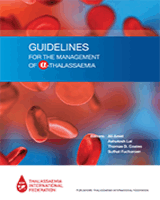From: Chapter 6, FERTILITY AND PREGNANCY IN α-THALASSAEMIA

NCBI Bookshelf. A service of the National Library of Medicine, National Institutes of Health.
Studies on the fertility outcomes of patients with α-thalassaemia are scarce. Individuals with HbH disease have a variable degree of anaemia and ineffective haematopoiesis, which can cause bone changes, and secondary iron overload [3–6]. In general, individuals with the most common form of HbH disease, the deletional form, have a mild degree of anaemia and ineffective erythropoiesis and rarely require red blood cell transfusions in the first decades of life. As a result, iron overload does not develop until adulthood, with little effect on fertility. Patients with more severe forms of HbH disease (non-deletional HbH disease), however, may require frequent or regular transfusions leading to more expedited iron overload. In addition, these patients may have a higher degree of ineffective erythropoiesis, leading to increased gastrointestinal absorption of iron and earlier iron overload. In such patients, endocrine complications can develop, which include growth failure, hypogonadotropic hypogonadism, hypothyroidism, and poor glycemic control or diabetes mellitus. [7–11].
From: Chapter 6, FERTILITY AND PREGNANCY IN α-THALASSAEMIA

NCBI Bookshelf. A service of the National Library of Medicine, National Institutes of Health.